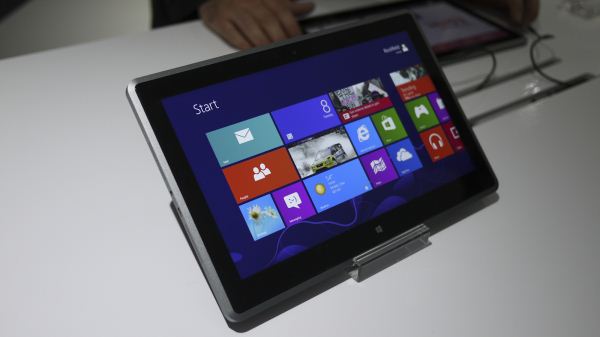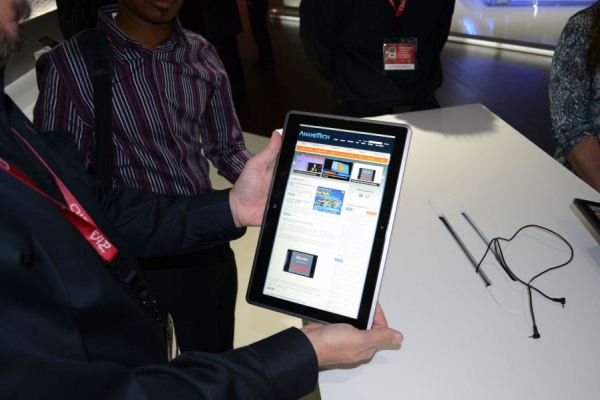Vizio's AMD Z60 Hondo-based Windows 8 Tablet PC at CES 2013
by Vivek Gowri on January 15, 2013 5:40 PM ESTEven with the comprehensive overhaul of their notebook lineup, the big news out of Vizio’s CES booth was definitely their new Windows 8 tablet. The Vizio Tablet PC is the first system we’ve come across with AMD’s Z60 APU inside. It’s a 1GHz dual-core part, with a pair of Bobcat cores and an HD 6250 GPU onboard. The low clock speed allows it to hit a TDP of roughly 4.5W, easily the lowest of AMD’s APUs, but likely means that compute performance will likely be similar to or slightly worse than Clover Trail. This isn’t unexpected, since we saw the same situation play out with Ontario last year - basically a faster microarchitecture clocked significantly lower such that it performed roughly on par with Atom, except with significantly better GPU performance.
In addition to the AMD Z60, the Vizio Tablet PC comes with an 11.6” 1080p display, 2GB of memory, a 64GB SSD, stereo speakers, and Vizio’s now customary industrial design and attention to detail. The chassis is pretty thin at 0.4”, and at 1.66lbs isn’t too heavy for a system of this form factor. It’s a nice design, very flat and clean, and feels good in hand. The frame is aluminum, with a soft-touch back and glass front. I'll explore the hardware fully in the review, but for now, just know that it's a good looking, well executed design.
My main comparison point was the Samsung ATIV Smart PC 500T, a Clover Trail-based 11.6” (1366x768) tablet which weighs a very similar 1.64lbs. The ATIV isn’t a particularly well designed system, which I’ll get into in my review, so the Vizio is unsurprisingly a much nicer piece of hardware design, but what really got me was the performance of Z60. Even at 1080p, the Vizio feels smoother throughout the Windows 8 UI than Clover Trail at WXGA. The extra GPU horsepower of the APU certainly makes itself felt when compared to the PowerVR SGX545 in Atom Z2760. This is a good sign, and all of the hardware acceleration capabilities that opens up should make Z60 a much more livable computing situation than Atom. Obviously, it won’t come anywhere near 7W IVB, which I’d say is the current preferred Windows 8 tablet platform (and should be until Haswell comes) but it should be a good deal cheaper.
The display is supposedly not IPS but is definitely some wide-angle panel type, so perhaps it’s a Samsung-sourced PLS panel or something similar. Pretty crisp, 1080p on an 11.6” panel is fantastic from a pixel density standpoint. We have no indications on price or release date, but Vizio says that it will be priced “competitively”. Competitive to what still remains a question, since the Z60-based Vizio kind of bridges the gap between Clover Trail and Ivy Bridge tablets, but I wouldn’t be shocked to see it drop at around $800. That puts it on par with the ASUS VivoTab 810C (the Atom one, not the one we reviewed) and just above the ATIV Smart PC ($749) but well below the 1080p Ivy Bridge tablets ($899 for Surface Pro, $949 for Acer’s W700).
I’m excited, it looks like a pretty decent offering and I’m glad to see AMD get such a solid design win. Intel has long owned the mobile and ultramobile PC space, so it’s nice to see AMD finally put out a viable chip that will hopefully shake things up going forward.


















32 Comments
View All Comments
themossie - Wednesday, January 16, 2013 - link
Not a problem for your use case (or, I suspect, most use cases) but I know some strange people...A surprising number of my non-techie friends don't have smartphones, and rely on a tablet as their main computer at home. Several of these have data plans for their tablets.
On my last smartphone, battery life was at a premium so I left background data off - relying on my tablet for notifications. I'd argue this is one of the few advantages of a tablet over a laptop for power users :-) But... yeah, most people use their smartphones for this. I'm really not sure how big an issue this is.
Wolfpup - Wednesday, January 16, 2013 - link
A Windows 8 tablet wouldn't be ideal, but could work for that, but I can't imagine trying to use an iPad to replace a real PC :-OHubb1e - Wednesday, January 16, 2013 - link
if your needs are really simple, like email and web browsing, then an iPad can easily replace your PC. For many people this is all they do with their PC so I've seen it quite often. They get a keyboard dock for that ipad and are perfectly happy on it. That's why these tablets are taking off because that use case represents a very large percentage of PC users.Wolfpup - Friday, January 18, 2013 - link
You're still stuck with a teeeeeeny tiny screen, limited web browser and multitasking, etc. Like I basically gave up using iOS to do something as simple as look at my email for forum responses and reply...it's just orders of magnitude more difficult than doing it on a real PC.Looking up an entry on IMDB or something? Slower, but not too bad...but much more complicated and it's just a terrible solution.
Wolfpup - Friday, January 18, 2013 - link
EDIT: Not to mention it's a terrible choice for any document files. No user accessible file system, terrible programs available, etc.nanfad - Wednesday, January 16, 2013 - link
How does the GPU stack up against the iPads?What about the iPads GPU vs Intel's HD 4000?
aicom64 - Wednesday, January 16, 2013 - link
The iPad 4's GPU does 71.6 GFLOPS while the HD 4000 does ~200 GFLOPS. While GFLOPS aren't everything, they do give you some idea of the performance delta between the best current mobile GPU and a relatively poor performing desktop part.twtech - Friday, January 18, 2013 - link
And to put that into context against high-end desktop GPUs, they are up in the 3,000-3,500 GFLOPS range, with the next generation coming soon expected to be up around 5,000 GFLOPS.I think some people start thinking, "My tablet has a 2GHz quad-core processor. Desktops only have 3ish GHz quad-core processors, so that means tablets will be as powerful as desktop PCs soon."
tipoo - Wednesday, January 16, 2013 - link
Still far behind the HD4000. The SGX cores are actually used in Intels older GMA graphics for Atom.Visual - Wednesday, January 16, 2013 - link
Nice to see an improved alternative to the Fujitsu Q572. The Vizio has better resolution and not so ridiculously large bezel size, but unfortunately it seems like it lacks an active digitizer.I'd readily pay $150-200 more for a version with Wacom.
Will there be a keyboard dock for this? Seems like a must-have nowadays...